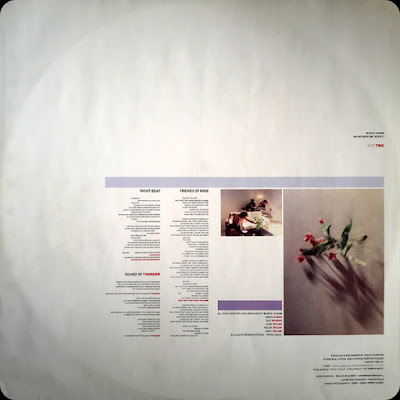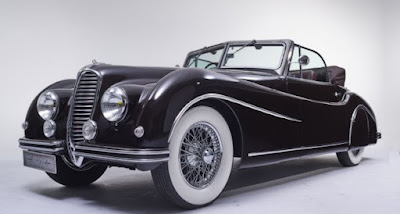Artist: Duran Duran
Album: Duran Duran
Year: 1981
Label: EMI
Design [Sleeve Design]: Assorted Images, Malcolm Garret
The Idea
“We asked Fin Costello, a photographer
whose work we liked, to shoot the album cover. I wanted an old car in the
picture, to give it a Gatsbyesque, neoclassical vibe. But I paid the price for
the suggestion, getting stuck at the back, my eyes barely visible. I’m not
crazy about the photo that was chosen for the cover of the album. None of us
were, as there were many better pictures of the band taken that year, but the
design that wraps around the image is superb.”
John Taylor (Duran Duran, bass guitar)
Design
“At Nick’s suggestion, EMI brought in Malcolm Garrett, who had designed all the Buzzcocks’ artwork. Malcolm created designs that were thoughtful and clean. His Duran cover is a classic. It could have been designed by the great minimalist architect John Pawson. The band logo—my favorite of all our logos—was expensive to produce, with silver foil strips added for emphasis.
It was classy.
It said, “We are the new breed.”
John Taylor
“I was a real fan of (Garrett’s)
work; I just thought he was brilliant. And what with the title of the single
being Planet Earth, and the whole sci-fi, futuristic connection of Duran
Duran’s name coming from Barbarella, I reasoned, well, the connections were
going to be made whether we liked it or not, so we might as well reflect that
to a certain extent. Garrett just seemed the perfect choice.”
Rob Warr
“Beyond a general discussion with Rob Warr (EMI label manager) that this was a band that had a fresh vision, I was effectively given free rein initially. They were one of a few bands calling themselves ‘New Romantic’ in what was already a post-punk world. I can’t actually recall that there was a brief as such. Knowing my work with bands such as Buzzcocks and Magazine, he just left me to get on with it.
 The name had been
taken from a character called Durand Durand in the futuristic science fiction
film ‘Barbarella’ starring Jane Fonda. I was a fan of this film myself, and it
naturally gave me a bit of further insight into what the band were about.”
The name had been
taken from a character called Durand Durand in the futuristic science fiction
film ‘Barbarella’ starring Jane Fonda. I was a fan of this film myself, and it
naturally gave me a bit of further insight into what the band were about.” Malcolm Garret (graphic designer)
“Their name and the title of the song, ‘Planet Earth’, suggested to me the kind of graphics that an airline identity might have in the 60s – a contemporary, almost space-age look. I was leaning towards clean modernism, far away from the punk DIY imagery that was already looking tired. I also had in mind that I could develop a graphic system that would give consistency to subsequent releases. This gave me a controlled graphic environment to work within, almost corporate in definition, but always luscious rather than conservative.
I’m not sure who chose the specific Fin Costello photo for the first album cover, but I ensured it followed the clean lines and modernist aesthetic that were maintained throughout the whole campaign surrounding the album. The chrome foil accenting the band logo and main images front and back emphasised a blend of glamour and futurism.
The photos I used on the inner sleeve were taken from actual 16mm film frames from the promo shot by i-D Magazine’s Perry Haines and Terry Jones for the second single, ‘Careless Memories’. I was always concerned with ensuring the visual links between the printed graphics with the new medium of video.”
Malcolm Garrett
The photographer
Fin Costello, the photographer of the group picture on the original 1981 sleeve, remembers that the shoot took place in an antique car sales garage, the Paradise Garage in Fulham in April 1981.

Fin Costello
The car
The Delahaye 135 is a luxury car manufactured by French automaker Delahaye. Designed by engineer Jean François, it was produced from 1935 until 1954 in many different body styles.
Image
John Taylor
"We always chose our own clothes and put things together ourselves. I remember the first time we encountered a stylist was the late 1980s. We hadn’t had a clue that people like this existed. [Before that] it was all very naive. We didn’t really have to think about it. We’d just go and find things that we liked and somehow we grew together. It’s like being in a gang, being in a band. Nothing was manufactured as many things are now. We got together from school . . . . It was definitely in our mandate [to find our own look], but we weren’t looking for something unnatural. We were actually just searching for things that we thought were cool and often we’d find women’s clothes, because actually men’s clothes weren’t particularly flamboyant at that time, so we’d literally go to small women’s boutiques and buy jackets off the shelf or a shirt that buttoned the wrong way for us, but it didn’t really matter. And you’d mix that up with leather trousers that you’d managed to find in Birmingham or from a biker shop or something, and then you’d find a shop like Kahn & Bell, which was a dream, because everything they made we wanted to wear."
Nick Rhodes
“Crossing over from the end of the 70s into the 80s, there wasn’t much money around. There was a lot of unemployment and young people thinking, Well if I can’t get a job I’m just going to do something myself. Quite often that’s what happens in times of recession: young people get really creative. It becomes about making your own clothes and your own way, being creative in your chosen field, simply because you couldn’t actually afford to buy it.”
Beverley Glick aka Betty Page (music journalist)
Singles
First three singles, "Planet Earth", "Careless Memories" and "Girls On Film", followed similar form as the self-titled debut album.
"Planet Earth"
"Careless Memories"
"Girls On Film"
In 1983 the album was reissued in the US to capitalize on the band’s success. The cover art
was completely different, with an updated band picture, different colour scheme
and new graphics.


















No comments:
Post a Comment